айвазовский биография на английском
Айвазовский биография на английском языке
Краткая биография Айвазовского на английском языке представлена в этой статье.
Иван Айвазовский биография на английском языке
Ivan Konstantinovich Aivazovsky was a Russian Romantic painter.
сvan Konstantinovich Aivazovsky (Hovannes Aivasian) was born on July 29, 1817, in Feodosia, Crimea, Russian Empire, into a poor Armenian family. His father was a modest Armenian trader. His mother was a traditional homemaker. His early talent as an artist earned him a scholarship to study at the Simferopol gymnasium. From 1833-1839 Aivasovsky studied at the Academy of Arts in St. Petersburg, where he was a student of professor Mikhail Vorob’ev, and graduated with the Gold Medal.
Aivazovsky was sent to paint in Crimea and in Italy, being sponsored by the Russian Imperial Academy for 6 years from 1838-1844. His numerous paintings of Mediterranean seascapes won him popularity among art collectors, such as the Russian Czars, the Ottoman Sultan, and among the various nobility in many countries. His dramatic depiction of a sea storm with the survivors from a shipwreck, known as ‘The Ninth Wave’ (1850), made him extremely famous. The original canvas is in the State Russian Museum in St. Petersburg. He also made many variations and repetitions of this particular painting, as well, as of his other popular works.
Aivazovsky produced over six thousand paintings of variable quality over the course of his long life. Most of his works were made on a longstanding commission from the Imperial Russian Navy Headquarters, where he worked for the most of his life, from the 1840s until 1900. He earned a considerable fortune, which he spent for charity, and also used for the foundation of the first School of Arts (in 1865) and the Art Gallery (in 1889) in his home town of Feodosia.
Aivazovsky was a member of Academies of Rome, Florence, Stuttgart and Amsterdam. He died on May 5, 1900, in Feodosia.
Презентация по английскому языку » Ivan Aivazovsky»(7-9 класс)
Ищем педагогов в команду «Инфоурок»
Описание презентации по отдельным слайдам:
Ivan Konstantinovich Aivazovsky (1817-1900)
Ivan Konstantinovich Aivazovsky (Hovannes Aivasian) was born on July 29, 1817, in Feodosia, Crimea, Russian Empire, into a poor Armenian family. His father was a modest Armenian trader. His mother was a traditional homemaker. His early talent as an artist earned him a scholarship to study at the Simferopol gymnasium. Здание Симферопольской мужской гимназии Феодосия
From 1833-1839 Aivasovsky studied at the Academy of Arts in St. Petersburg, where he was a student of professor Mikhail Vorob’ev, and graduated with the Gold Medal.
His numerous paintings of Mediterranean seascapes won him popularity among art collectors, such as the Russian Czars, the Ottoman Sultan, and among the various nobility in many countries. His dramatic depiction of a sea storm with the survivors from a shipwreck, known as ‘The Ninth Wave’ (1850), made him extremely famous. The original canvas is in the State Russian Museum in St. Petersburg. He also made many variations and repetitions of this particular painting, as well, as of his other popular works. The Ninth Wave is his «most celebrated work». Aivazovsky is considered one of the most prominent Russian artists (especially in marine art) and one of the greatest marine artists of the 19th century. И. К. Айвазовский. Картина «Девятый вал»
Национальная картинная галерея им. И.К. Айвазовского He earned a considerable fortune, which he spent for charity, and also used for the foundation of the first School of Arts (in 1865) and the Art Gallery (in 1889) in his home town of Feodosia.
музей Айвазовского в Феодосии
Aivazovsky was a member of Academies of Rome, Florence, Stuttgart and Amsterdam. He died on May 5, 1900, in Feodosia.
Памятник И.К. Айвазовскому в Феодосии Памятник И.К. Айвазовскому в Ереване
Потомки И.К.Айвазовского из Австралии на праздновании его 200-летия в Феодосии
Телега, запряженная волами и парусник
Айвазовский «Кораблекрушение у скал»
«Вид на Золотой Рог»
Курс повышения квалификации
Дистанционное обучение как современный формат преподавания
Курс повышения квалификации
Специфика преподавания английского языка с учетом требований ФГОС
Курс повышения квалификации
Актуальные вопросы преподавания английского языка в условиях реализации ФГОС
Номер материала: ДБ-1043004
Международная дистанционная олимпиада Осень 2021
Не нашли то что искали?
Вам будут интересны эти курсы:
Оставьте свой комментарий
Авторизуйтесь, чтобы задавать вопросы.
Минобрнауки утвердило перечень олимпиад для школьников на 2021-2022 учебный год
Время чтения: 1 минута
Около половины детей болеют коронавирусом в бессимптомной форме
Время чтения: 1 минута
В школе в Пермском крае произошла стрельба
Время чтения: 1 минута
Российские педагоги чаще всего жалуются на излишнюю отчетность и низкую зарплату
Время чтения: 2 минуты
Средняя зарплата учителей в Москве достигла 122 тыс. рублей
Время чтения: 1 минута
Рособрнадзор открыл горячую линию по вопросам контрольных в школах
Время чтения: 1 минута
Подарочные сертификаты
Ответственность за разрешение любых спорных моментов, касающихся самих материалов и их содержания, берут на себя пользователи, разместившие материал на сайте. Однако администрация сайта готова оказать всяческую поддержку в решении любых вопросов, связанных с работой и содержанием сайта. Если Вы заметили, что на данном сайте незаконно используются материалы, сообщите об этом администрации сайта через форму обратной связи.
Все материалы, размещенные на сайте, созданы авторами сайта либо размещены пользователями сайта и представлены на сайте исключительно для ознакомления. Авторские права на материалы принадлежат их законным авторам. Частичное или полное копирование материалов сайта без письменного разрешения администрации сайта запрещено! Мнение администрации может не совпадать с точкой зрения авторов.
Prominent Russians: Ivan Aivazovsky
Ivan Aivazovsky was a famous Russian artist specializing in seascape and landscape portraits. He was born into the family of a destitute Armenian merchant in the Crimean city of Feodosia on 17 July 1817. At the time of Aivazovsky’s birth the city was devastated after a recent war and was still suffering from the consequences of a plague epidemic that had affected the region in 1812.
Aivazovsky’s childhood was spent in poverty on the outskirts of the city facing the beautiful Feodosia Bay and the ruins of an ancient Greek fortress. Young Ivan was mesmerized by the grandeur of the view and the heroic stories told about the Greeks and the famous battles of the past.
His talent was discovered at a very early age. He was taken on as an apprentice by a local architect and later sent to a gymnasium in Simferopol where he showed such amazing artistic skills that influential locals helped him
move to St. Petersburg to enter the Academy of Art. His first success came in 1835 when his sketch “Air Over Sea” received a silver medal in an art competition. It was at this time that Aivazovsky met Mikhail Glinka, Vissarion Belinsky, Ivan Krylov and Vassily Zhukovsky.
In 1836 the French artist Philippe Tanner came to teach at the academy and noticed the promising youth. He was a master of marine paintings and showed Aivazovsky his tricks – in the fall of that same year Ivan put five of his own marine canvases on exhibit. The artist was noticed by the press and critics. The following year he was awarded a gold medal for his works “Still Bay of Finland” and “The Roads Near Kronstadt” and received the official title of artist.
He was trusted by the academy to continue his work on his own and moved back to Crimea where he set up a shop and started painting his beloved Black Sea. He did most of his painting outside, watching the elements, and only going indoors to put the finishing touches on his masterpieces.
In 1839 Aivazovsky took part in a Navy operation off Caucasian shores, meeting prominent admirals of the time and becoming friends with them for life. The raid inspired a series of battle paintings and the artist’s courage in battle earned him much respect in the Navy and a good reputation among the officers. His canvases depicting sea battles are remarkably true to fact and so full of accurate details that they may be considered illustrations of naval attack tactics.
The following year the artist undertook his first trip abroad – by then he was a known seascape master and his fame preceded him in all his travels through Italy, Germany, France, Holland and Spain. In Italy Aivazovsky met Nikolay Gogol and renowned artist Aleksandr Ivanov. Upon his return to Russia Ivan Aivazovsky was given an official title within the General Naval Office which later allowed him to join Russian research and science expeditions to Turkey, Greece, Egypt, America and Asia to bring home even more marine impressions and hundreds of sketches that are reflected in his most famous works of art.
In 1846 Aivazovsky built his own workshop in his native Feodosia and spent most of his time there, behind closed doors, producing one picture after another. He no longer needed to go outdoors for inspiration– he’d already seen so much of his beloved environment that he was able to produce canvases with amazing speed, almost that of a printing machine. By this time the artist has perfected his technique and invented so many tricks that he often astonished his visitors by creating a large canvas in a matter of hours.
Aivazovsky frequently compared his work to that of a poet. “The artist who only copies nature becomes a slave to nature. The motions of live elements are imperceptible to a brush: painting lightning, a gust of wind or the splash of a wave. The artist must memorize them. The plot of the pictures is composed in my memory, like that of a poet; after doing a sketch on a scrap of paper, I start to work and stay by the canvas until I’ve said everything on it with my brush.”
His life in the quiet coastal Feodosia was quite uneventful. He spent days in his workshop mixing paints and producing seascapes and in winters went to St. Petersburg to exhibit his works for the sophisticated public of the Russian capital. Although he lead a secluded life, Aivazovsky kept in constant touch with his great contemporaries, welcomed them at his home in Feodosia and arranged meetings with them in St. Petersburg.
Aivazovsky’s greatest masterpiece is considered to be “The Ninth Wave,” executed in 1950. An early dawn after a night storm, the first rays of light touch the surface of the raging ocean and the fearsome ninth wave is ready to crush a small group of people struggling for their lives among the wreckage. Although the situation seems desperate, the picture still leaves the viewer with a glimmer of hope – it’s full of light from the rising sun that brings yet another day.
In 1868 Aivazovsky traveled to the Caucasian mountains and painted the reefs with their pearly white snowcaps, like waves of stone. A number of paintings of the southern Caucasus are recognized as masterpieces.
Dostoevsky was an admirer of Aivazovsky’s art and “The Rainbow” was his favorite work. It marked the first time in Russian art that a painter had created a scene of a storm as if seen from inside the raging sea. Dostoevsky wrote, “This storm by Aivazovsky is fabulous, like all of his storm pictures, and here he is the master who has no competition. In his storms there is the trill, the eternal beauty that startles a spectator in a real life storm.”
The last decade of the artist’s life was dedicated to experimentation. For example, Aivazovsky tried his hand at portraits of daily life. Most of his works from this period were unsuccessful, though the hand of a great master clearly shows. His canvas “The Wedding in Ukraine” (1891) depicts a village wedding: the newlyweds, their guests and young musicians are singing and dancing in their bright clothes in the garden in front of a simple peasant hut. It’s hard to believe a marinist painter created this jolly picture.
In 1898 Aivazovsky created “Among the Waves,” the painting that is recognized as the pinnacle of his art. In it a thunderstorm rages above the boiling sea. There is no debris or destroyed ships or any other usual tricks of drama and tension; the waves crushing against one another create an extremely powerful image. It is one of the few canvases the artist never exhibited, bequeathing it instead to his art gallery in Feodosia.
Aivazovsky died on 19 April (2 May) 1900 at the age of 82.
The heritage left behind by Ivan Aivazovsky is huge – over 6000 canvases. But not all of them can be called masterpieces; some are simple copies of the same theme with minor variations, some are quite mediocre, but the masterpieces such as “The Ninth Wave” (1850) or “The Black Sea” (1881) cause viewers to hold their breath at the sight of the endless, enchanting, almighty sea.
Aivazovsky, although a romantic, was also a very practical man. He was among the first artists to personally exhibit his creations in major cities. He enjoyed a generous income and spent much of his wealth on the welfare of his hometown: in 1865 he opened a painting school in Feodosia, and in 1880 an art gallery.
Legal disclaimer Feedback Contact us © Autonomous Nonprofit Organization “TV-Novosti”, 2005–2021. All rights reserved.
Ivan Aivazovsky
Ivan Aivazovsky
When Aivazovsky began his career, Russian art was still dominated by Romanticism and it was the romantic mood which set the terms for Russian landscape painting in the second half of the nineteenth century. It is scarcely surprising then to discover romantic elements both in Aivazovsky’s early works, and in the majority of his later ones. One reflection of this is his choice of subjects again and again we find him depicting shipwrecks, raging sea battles and storms.
Aivazovsky continued in the tradition of the great Russian landscape painters of the early nineteenth century without recourse to imitation. He created a new tradition, a new school of painting, thus making his mark on the marine painting of his own and subsequent generations.
Apart from his work as an artist, Aivazovsky was a tireless and versatile public figure: he took an eager interest in world events and sympathized deeply with small nations struggling for their independence. At the same time he worked selflessly for the good of his native town Feodosiya and did much to assist young artists.
Aivazovsky was born on 17 July 1817 (29 July New Style) in the ancient Crimean town of Feodosiya, where his father, an Armenian by nationality, had settled at the very beginning of the century. His father was a relatively well-educated man who knew several oriental languages, and who, though a trader of small means, played a significant part in the commercial life of the town. Unfortunately the plague epidemic which hit Feodosiya in 1812 wrecked his business, and when the future artist was born, the family had indeed fallen on hard times. There is some evidence to suggest that poverty obliged the young Aivazovsky to work in the cosmopolitan coffee-shops of Feodosiya, alive with the chatter of many different tongues: Italian, Greek, Turkish, Armenian and Tartar. The young boy’s eager mind soaked up all the colourful sights and sounds which Feodosiya with its mixed population had to offer. He also had a keen musical ear and soon learned to play folk melodies on the violin. Later Aivazovsky recalled some of thesemelodies for his composer friend Mikhail Glinka, who used them in his compositions. It was drawing, however, which most seized the young boy’s imagination: lacking other materials he drew in charcoal on the whitewashed walls of Feodosiya. These drawings attracted the attention of A. Kaznacheyev, the town-governor, who helped Aivazovsky to enter the high school at Simferopol and in 1833, the St Petersburg Academy of Arts.
Aivazovsky’s student days in St Petersburg coincided with a confused and in many ways contradictory phase in Russian history. On the one hand it was a period of harsh tyranical rule and political stagnation under Tsar Nicholas I, on the other it witnessed a great flowering of Russian culture, beginning after the Napoleonic War of 1812. This was the age of Pushkin, Gogol, Lermontov, Belinsky, Glinka and Briullov. Within the Academy the canons of Classicism, closely linked to ideas of civic duty and patriotism, still held sway, but the new stirrings of Romanticism were also discernible.
The great success of Karl Briullov’s picture The Last Day of Pompeii made a lasting impression on Aivazovsky, summing up as it did the victory of the Romantic school in Russian painting. Both the picture and Briullov himself played an important part in stimulating Aivazovsky’s own creative development. Furthermore, Aivazovsky was brought up in the romantic spirit by his teacher in the Academy landscape class, M. Vorobyov. In general Russian art of the first half of the nineteenth century combined Romanticism with Realism and very often both principles found expression in an artist’s works. This was especially evident in landscape painting, an essentially realist art form which continued romantic features for a long time. Aivazovsky acquired a romantic outlook in his student years and maintained it in maturity. He remained to the end one of the most faithful disciples of Romanticism, although this did not prevent him from evolving his own form of realism.

«Aivazovsky’s pictures. reveal without a doubt that his talent will take him far. Study of nature will open up to him further treasures, whose existence his talent scarcely suspects at present. » Thus wrote The Art Gazette, noting the artist’s «inherent poetic gift». One of Aivazovsky’s early canvases, The Great Roads. Kronstadt, is reproduced in this album. Although the foreground of the picture with its naively drawn human figures recalls the old Dutch masters, the perspective has breadth and depth, with spray-soaked clouds receding into the distance. The waves seem fixed and motion less, but nevertheless Aivazovsky has somehow captured the specific character of the cold Baltic Sea.
In October 1837 Aivazovsky completed his studies at the Academy and received the great gold medal, which gave him the right to a prolonged course of study abroad at the expense of the Academy. Bearing in mind the peculiar nature of Aivazovsky’s gift, the Council of the Academy took an unusual decision. To begin with the artist was to be sent to the Crimea for two summers; there he was to perfect his skills in his chosen genre by painting views of the coastal towns while sending his pictures each year to the Academy. Only after this was he to leave for Italy.
Once back in Feodosiya, Aivazovsky lost no time in setting to work. Indeed, his industriousness always surprised those who knew him, and soon a whole succession of Crimean views had appeared on his easel. His love of his native landscape was manifest in each picture.
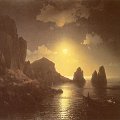
In the summer of 1840 Aivazovsky returned to St Petersburg before setting off on his scholarship journey. By September he was already in Rome. Here, as in Petersburg, he made the acquaintance of some of the outstanding men of the time. He became friendly with Nikolai Gogol and was on good terms with Alexander Ivanov and other Russian artists living in Rome. Not for the first time friendship with some of his most gifted contemporaries had a beneficial effect on Aivazovsky and his work.
Meanwhile he continued to paint prolifically. His pictures appeared regularly in Italian exhibitions, bringing him unusual renown. News of this got back to St Petersburg and The Art Gazette published a big article on his success in Italy:
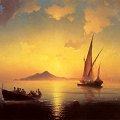
The leading artists of the day recognized Aivazovsky’s mastery and talent. During a trip to Italy in 1842 the famous English marine painter, Joseph Mallord William Turner was so struck by the picture The Bay of Naples on a Moonlit Night that he dedicated a rhymed eulogy in Italian to Aivazovsky:
In this your picture
Of a mighty king!
I see the moon, all gold and silver.
Forgive me if I err, great artist,
Reflected in the sea below.
Your picture has entranced me so,
And on the surface of the sea
Reality and art are one,
There plays a breeze which leaves a trail
And I am all amazement.
Of trembling ripples, like a shower
So noble, powerful is the art
Of fiery sparks or else the gleaming headdress
That only genius could inspire!
While major artists praised Aivazovsky, others began to deliberately imitate him. In Italy, where previously there had been none, seascapes began to appear in large numbers in art shops and stalls.
Aivazovsky enjoyed equal success when he brought his pictures to Paris in 1842, having been granted permission from the Academy. The Council of the Paris Academy awarded him first their gold medal, then, in 1857, the Legion of Honour-an order rarely conferred on foreigners. Horace Vernet, the well-known French battle-painter, told Aivazovsky that his talent was a credit to his native land.
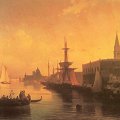
It is interesting to compare Aivazovsky with the Russian artist Sylvester Shchedrin, who died in Italy only ten years before Aivazovsky set foot on Italian soil. Shchedrin had broken with the academic tradition of conventional landscapes in the 1820s. His pictures had been painted directly from life and combined severe realism with a certain sense of poetry. Shchedrin was idolized by those young artists who yearned to achieve truth in their art. Aivazovsky’s favorite subject-matter was very close to that of Shchedrin, and he too was under the spell of his great predecessor. It was his aim to follow in Shchedrin’s footsteps.
The underlying principle of Shchedrin’s endeavor was to paint strictly from life. This was the way Aivazovsky had painted in the Crimea and this was the way he began to paint in Italy. Wishing to discover the secret of Shchedrin’s art, he even tried painting a landscape from exactly the same spot as Shchedrin A picture might be accurate and exact, but it would be sterile without the pulse of life within it. The viewer would see familiar places and painstakingly reproduced details, but would remain indifferent to what he saw. Instead of copying direct from nature, then, Aivazovsky tried to create a picture of the shimmering, leaping sea from memory in his studio. A miracle occurred-it was as if the sea had really begun to sparkle and shimmer, filled with incessant movement. The artist had discovered his own method of depicting nature from memory, even without preliminary studies, limiting himself to hurried pencil sketches. Justifying his method theoretically, the artist observed: «The movement of the elements cannot be directly captured by the brush-it is impossible to paint lightning, a gust of wind, or the splash of a wave, direct from nature. For that the artist must remember them. « Aivazovsky’s phenomenal power of recall and his romantic imagination enabled him to employ this method with unsurpassed brilliance. At the same time, the speed and ease with which he painted caused him to repeat himself occasionally allowing elements of cliche and salon prettiness to creep in. A pupil of the Academy, Aivazovsky could not entirely free himself of the tendency to «improve» on reality. On the whole, however, the method invented by Aivazovsky suited both his creative idiom and the spirit of the times. Very quickly he reached the peak of his fame. In the spring of 1845 Aivazovsky set off on a voyage around the coasts of Asia Minor and the Greek archipelago on a ship commanded by Admiral F. Lutke, a noted scholar and founder of the Russian Geographical Society. Once again Aivazovsky plunged into intensive work and his sketch-books were soon filled with new impressions. On his return he settled in the Crimea for a while to paint Black Sea coastal scenery and towns he had visited during the recent voyage. The pictures of this period are among his best, especially those in which he depicts Constantinople and Odessa. Here, in the shimmering gold of sky and water, the moonlit buildings, the romantic silhouettes of statues, indeed in the whole colour scheme we sense that same vision of the beautiful and exotic south which inspired many of Pushkin’s poems. The young Aivazovsky had been introduced to Pushkin at the Academy exhibition of 1836 and all his life he revered the poet. Several times he painted Pushkin standing by the sea. The best of these pictures was the one painted jointly with Ilya Repin in 1887. By the mid-1840s Aivazovsky was already thinking of settling permanently in Feodosiya, since the role of court painter held little attraction for him. He preferred to work steadily at his paintings in a peaceful provincial seaside town. Thus Aivazovsky stayed in Feodosiya for the rest of his life. He travelled occasionally to St Petersburg and visited Moscow from time to time, he made journeys to the Caucasus, along the Volga, to Turkey and to America and his exhibitions were successful wherever he went; but Feodosiya always remained his real home. It was there that he produced his best canvases. Some forty years after settling permanently in Feodosiya, Aivazovsky financed the erection of the picture gallery there which bears his name. It now houses 130 pictures and 270 sketches by Aivazovsky himself, as well as works by Lagorio, Vessler, Latri, Voloshin, Bogayevsky and others connected with the eastern Crimea, a place of ancient culture and severe but picturesque landscapes. Aivazovsky’s links with the Russian Navy grew stronger. He was revered by the Navy in a way unparalleled in the history of art. In 1846, for example, the Navy marked the tenth anniversary of Aivazovsky’s artistic career: Admiral Kornilov sent a special squadron of battleships from Sevastopol to congratulate the artist. Another of this group of pictures, entitled The Battle of the Straits of Chios, is full of inner tension. Here Aivazovsky very skillfully achieved the effect of depth by alternating the silhouettes of near and distant ships. A third picture painted at the same time is The Brig «Mercury » where the battle is already over. A small ship with battered sails is returning to the main Russian fleet (visible on the horizon) after successfully undertaking a heroic raid. In the second half of the nineteenth century realistic trends became dominant in Russian culture and did not pass by Aivazovsky. The new spirit of conscious and consistent realism had its effect on his work as on that of many others, but his romantic inclinations persisted. During the Crimean War of 1853-56 Aivazovsky spent some time in besieged Sevastopol and made some sketches there. However, this war, conducted mostly on land, found little reflection in his work, despite the fact that from this time onwards «dryland» subjects attracted his attention more and more often. He knew the endless Ukrainian steppes well because he had often crossed them on his journeys to St Petersburg. Their infinite expanses fired his imagination, and from now on we often find peasant carts in the cornfields and Ukrainian farm-houses in Aivazovsky’s pictures. During the 1860s many Russian artists of democratic inclination became interested in the peasant theme and it was probably this general trend which turned Aivazovsky’s mind in that direction; nevertheless the academic tradition in art did not allow the artist to fill his picture with the tendentious social content that characterized the real «men of the ‘sixties». The pictures painted by Aivazovsky at this time are not among his best. In the 1860s Aivazovsky turned to another subject close to his heart. In 1867 the Greeks living on Crete started a rebellion against Turkish rule. Ever since his childhood Aivazovsky had felt a special sympathy for the Greeks in their struggle for liberation, and now he painted a picture called On the Island of Crete, capturing the dramatic moment when the rebels bid farewell to their women and old folk who are being evacuated on a Russian ship. The mood of nature corresponds to the feelings of the people: over the sea there is a bright cloudless sky, but over the island the storm clouds thicken, darkening the valleys and ravines; the trees are bent by the wind-a storm is coming. Even a certain degree of melodrama in the depiction of the figures in the foreground does not reduce the overall air of tension and foreboding. In a way this reflected Aiva-zovsky’s own state, for at the age of fifty he was on the verge of a new upheaval in his artistic evolution. The final third of the nineteenth century witnessed a flowering of realism in all genres of Russian art. It was then that the members of the Society for Circulating Art Exhibitions (the Peredvizhniki) were creating their best works, and names like Repin, Kram-skoi, Surikov, Shishkin and Levitan came to the fore. Aivazovsky’s talent also took a new direction at the beginning of the 1870s. The somewhat sugary picturesqueness of his early works gave way to a more realist vision of the world. The romantic tension does not leave his pictures but takes on a sterner, more restrained character. In The Rainbow (1873) the artist uses more subtle colouration as if he had begun to look at the sea with new and more discerning eyes. The waves and spray-soaked air are painted more authentically than before. At first sight there is nothing unusual in the picture Moonlit Sea (1878)-the full moon penetrating a light cloud-cover, the line of mountains in the distance, the moon’s reflection stretching like a watery pathway, broken by ripples. But all of this is painted in a new way: the movement of the waves is more intense, there is a more imposing sense of space and the beauty of the southern night is more subtly conveyed. Aivazovsky’s greatest achievement in this period is The Black Sea (1881). Here the artist created a generalized image of the marine elements in their ever-changing manifestations. The distant horizon is calm, but towards the foreground the sea gets rougher and waves break the smooth surface of the water. In the immediate foreground the water forms great waves, crested here and there by foam. Their measured rocking movement and the vastness of the sea are conveyed with exceptional power. So far the water has only begun to seethe, yet its motion is already relentless and frightening. The fine blue of the sky is being overtaken by a dense, grey wall of clouds; coloured shadows appear on the water with dappled patches and highlights-some blue, some turquoise or pure green-just as in reality. Ivan Kramskoi, who was a discerning and sensitive critic, wrote of this picture: «There is nothing in it but sky and water, yet the water is a boundless ocean, not rough, but restless, severe, infinite, and the sky is, if possible, more infinite still. It is one of the most powerful pictures I know.» Aivazovsky maintained his capacity for work, his energy and lively creative intelligence until the very end of his life. All in all he painted more than 6,000 pictures and a multitude of skillfully executed drawings. Many of his works have taken their places among the greatest achievements of visual art. Kramskoi referred to Aivazovsky as «a star of the first magnitude» and thus correctly established the painter’s place in the pantheon of Russian art. Fate was kind to Aivazovsky, bestowing on him a clear mind and rich soul. He worked all his life in a congenial setting of his own choice; he received in his lifetime all the signs of official recognition which he deserved; his talent was universally acclaimed. From his home in Feodosiya Aivazovsky worked for the good of its inhabitants and the development of the region, taking this role very seriously. He supplied the town with water from his own estate, he opened an art school, began the first archaeological excavations in the region and built a historical museum. Finally, thanks to his efforts a commercial port was established at Feodosiya and linked up to the railway network. By these and other deeds Aivazovsky earned the love and respect of the townspeople. To this day the principal sights of the town are his picture gallery and his grave near an ancient Armenian church. Aivazovsky died on 19 April (2 May New Style) 1900, on the verge of the twentieth century, leaving unfinished a picture he had begun that same day. Whatever lies ahead for Russian art there is no doubt that the creative legacy of Aivazovsky will always be a treasured part of its history. 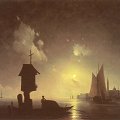
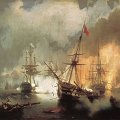
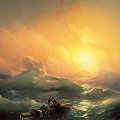
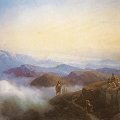
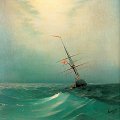
Biographical Outline
Ivan Aivazovsky Art
Articles

Romanticism
Ivan Aivazovsky
Life and biography.



